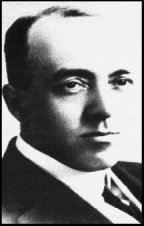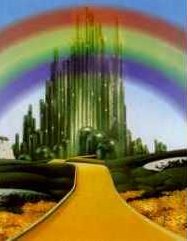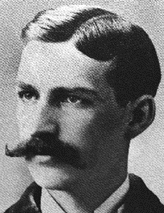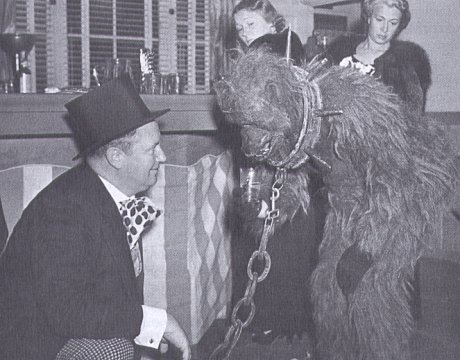IN THE HALL
OF THE MOUNTAIN KING



Edgar Rice Burroughs and L.
Frank Baum
by
R.E. Prindle
Wondrous indeed is ERB's ability to incorporate
obvious influences from a multitude of sources combining them with his
own original ideas to concoct an incomparable blend. In many ways
he was like a conductor of a symphonic orchestra - strings, wind and brass
all contribute along with the steady throbbing of the jungle tom-toms to
a harmonic whole that is sheer brilliance under his skillful pen.
Rider Haggard and Conan Doyle.
Jules
Verne
and Jack London. Zane
Grey and
Rudyard Kipling. Robert W. Service
and H.H. Knibbs.
The list goes on and on. Some are represented in his library as presented
here on ERBzine, some aren't.
As far as I have been able to determine if a title is in the library you
can look for its influence in the corpus somewhere.
Many of these writers are not slight influences
but fundamental to Our Man's storytelling. Just when you think there
couldn't be another obvious pervasive influence up pops L. Frank Baum
and his Oz series.
My fellow ERBzine writer David Adams has insisted
on the influence but I gave his opinion only cursory attention. I
had other things to do at the time. ERBzine
0303 ~ ERBzine 0304
~ ERBzine 1123
On further reflection I found there are three
Baum
titles in the library - Ozma
Of Oz, Rinkitink
In Oz and Glinda
Of Oz. An odd group of titles, I thought. No Wizard
and No Land Of. The list begins with the third title in the
series, Ozma Of Oz.
Then after completing the writing of ERB's
three women I found myself with Tarzan
And The Golden Lion in my hand. Literally, and I wasn't
sleep walking either. Don't know how it got there; don't know why
but there it was. I suddenly said, I'm a sudden sort of guy, says
I, I'll do this next. Maybe because the quartet of Tarzan novels
- Tarzan The Untamed,
Tarzan
The Terrible,
Tarzan
And The Golden Lion and Tarzan
And The Ant Men all seemed to be involved with ERB's troubled relationship
with his first woman, Emma.
Maybe the choice was understandable but then
some inner voice whispered - Read the three Baum novels first. David
seemed really convinced about Baum so I checked the dates of Baum's stories
not really being willing to invest the time. Ozma was published
in 1907 which seemed a most significant date, Rinkitink in 1916
and Glinda in 1920. My course of action was now clear in my
mind. I picked up my Dover edition of Ozma
and began to read.
BINGO!
Here was the catalyst that set ERB's pen in
motion.
He may have read The
Wonderful Wizard Of Oz sometime after it was issued in 1900, maybe
even between 1900 and 1903 when he took Emma to the wilds of Idaho.
He may have read The
Land Of Oz sometime after 1904 when it was issued but neither of
those titles made a transcendent impression on him. The series didn't
burst into living color in his mind until Ozma. The first two Baum
books may compare with the first four Tarzans as predecessor volumes.
Both Baum and Burroughs seemed to be searching their metier for the right
road to follow. Each writer reached a sort of dead end. Baum's
first two lead up to the creation of Ozma when the series blossoms
while the first four Tarzans lead up to the Jewels
Of Opar when the Big Bwana really begins to fit his g-string.
Introduced in Land Of Oz, the boy-girl
Ozma, the Teresias of modern times, comes into his/her own in Baum's third
volume. Baum, perhaps at a loss as to what to do after the rather
pedestrian Land Of Oz, ransacked Greco-European mythology to come
up with Ozma. He combined mythology with the Esoteric Gnosis, as
David points out, to come up with a very appealing blend. The result
as expressed in Ozma provided ERB with enough material to populate a dozen
of his own novels or more.
Ozma triggered ERB's desire to write.
He may have publicly said he was embarrassed at being a writer because
he didn't consider it manly but when he had a chance for a successful
career at Sears, Roebuck he threw it over for what? A series
of dead end jobs? Not likely. He always had it in mind to be
a writer. Denying it was just some kind of public relations.
There is some discussion among Bibliophiles
as to when ERB's maiden effort Minidoka
was written. Following Bob Barrett who wrote the introduction to
Minidoka the belief is that it was written in 1903-04 when ERB was still
in Idaho using The Wizard Of Oz as a basis for the obvious Oz influences.
I have argued elsewhere for a date of 1908-09 for which Ozma is
conclusive proof. The references to Oz in Minidoka reflect Ozma
so that Minidoka couldn't have been written before 1907 or whenever Burroughs
read Ozma, certainly no later than 1908.
So, Minidoka must have been written
in 1908-09. As a first effort the book, or rather long short story,
is interesting without being compelling. ERB obviously saw its shortcomings
so he put it in a drawer while he reorganized his thoughts. The book
remained unpublished until Dark Horse published it in 1998.
Roughly two years later the story jelled in
his mind so that he was able to write A
Princess Of Mars. The whole John Carter Trilogy reflects
the Ozma influence, among many others of course. Dante not
being among the least as both David and I discovered.
The Wonderful Wizard is Baum's Tarzan
Of The Apes that establishes his fantastic premise. Land
Of Oz is a rather commonplace follow up, interesting but strained and
not very exciting. And then Ozma.
Just as though shape shifting from one realm
of imagination to another, girl from boy, Ozma begins with a huge storm
at sea reminiscent of the many such storms in Burroughs novels. Apparently
when ERB read it he said 'I know the feeling.' Aboard the ship was
little Dorothy Gale and her Uncle Henry. Dorothy was the heroine
of the first book in the series. She is very appropriately named
Gale as a tornado transported her to Oz the first time and now a typhoon.
Baum apparently associated her in his mind with big winds. In her
case the ship doesn't sink but she is washed overboard in a chicken coop.
Honest to God. Took a certain amount of imagination to come up with
that one, didn't it? Dorothy and her chicken coop successfully ride
out the storm along with a surviving Yellow Hen which talks and is especially
proficient at laying eggs. Eggs will be important in this story.
As in Burroughs the ship has been traveling
southerly into the South Seas. After the storm abates land is sighted
and the chicken coop drifts ashore. There's Burroughs all over, the
wreck at sea, the search for land and the desert shore.
The chicken coop lands in front of a big rock.
Then Dorothy
walked back up the path, and followed it until she came to the very top
of the hill, where a solitary round rock stood that was bigger than any
of the others surrounding it. The path came to an end just beside
this great rock and for a moment it puzzled the girl to know why the path
had been made at all. But the hen, who had been gravely following
her around and was now perched upon a point of rock behind Dorothy, suddenly
remarked:
"It looks something
like a door, doesn't it?"
"What looks like a door?"
enquired the child.
"Why, that crack in
the rock, just facing you, "replied Billina, whose little round eyes were
very sharp and seemed to see everything. "It runs up one side and
down other, and across the top and bottom."
"What does?"
"Why the crack.
So I think it must be a door of rock, although I don't see any hinges."
"Oh yes," said Dorothy,
now observing for the first time the crack in the rock "And isn't
this a key-hole Billina?" pointing to a round deep hole at one side
of the door.
"Of course. If
we only had a key, now, we could unlock it and see what is there," replied
the yellow hen, "may be it's a treasure chamber full of diamonds and rubies,
and heaps of shining gold, or--"
And indeed, when the tor was
transported by ERB's imagination to the plain by the side of Opar in Tarzan
And The Jewels Of Opar it was filled with jewels and gold. So
we have a direct connection to Opar from Oz.
Dorothy and the hen having released Tik Tok
a mechanical man from the rock all make their way to the palace of Langwidere
of Ev. This very interesting woman is the model for Burroughs Rykors
and Kaldanes. Burroughs characteristically reverses the situation
making the heads permanent rather than the bodies. Langwidere's body
is permanent while she has 31 heads, one for each day of the month, of
which she selects one most appropriate for the occasion. She selects
a haughty one to greet Dorothy, the hen and Tik Tok.
"Tell me," she
resumed, "are you of royal blood?"
"Better than that, ma'am,"
said Dorothy. "I came from Kansas."
That's a credential that can't be denied, eh what?
Langwidere should have replied 'Well, you're not in Kansas anymore.' but
she missed her cue.
As it turns out the Princess' family has been
enchanted by the Nome King (read Gnome) who lives in a mountain.
Dorothy et al. set out to retrieve the family which necessitates a visit
to the Hall Of The Mountain King.
Here Baum really mines Greco-European mythology
to make a story that really glitters.
The journey to the Mountain King is reminiscent
of Theseus' trip across the Isthmus of Corinth. Successfully surmounting
all the obstacles the group is admitted to the Hall of the Nome King.
Nome may be an abbreviated form of Gnome as the king is a gnome.
The name might also be related to the Egyptian political division of Nomes.
Baum and his wife were Theosophists, as David points out, so that they
would be quite familiar with the ancient Gnosis. The story of Ozma
of Oz is indication enough of Baums's familiarity with Greco-European
mythology and folklore.
The influence of Ozma on Burroughs is
more than evident. There is some discussion among Bibliophiles as
to whether Burroughs himself was into Theosophy. At least by 1916
if not on his first trip to California in 1913, Baum moved to California
in 1910, Burroughs and Baum had met becoming friends. They were intimate
enough, at least, for Baum to recommend him for membership in his Uplifters
Club in 1917.
Baum must have known who Burroughs was.
In 1916 in order to have read much of ERB Baum would have had to have been
familiar with Burroughs' magazine versions of his stories as by 1916 only
Tarzan Of The Apes had been out for two years while the Return
had just been issued in 1915 in book form.
If Baum had read the John Carter Trilogy in
magazine form he would have recognized the Esoteric influences whether
he realized that they derived from Ozma or not. Awareness of the
Esoterica would have drawn him to Burroughs and must therefore have formed
a basis for the their conversation.
ERB had an omnivorous curiosity so that while
the Gnosis is too irrational for a rational mind to accept it is nevertheless
a phase through which HSII and III consciousness has passed. One
would inevitably compare it to Orthodox Christian thinking and Science.
I think Burroughs must have.
Esoterica itself is the foundation of imaginative
literature in the twentieth century whether fantasy, horror or science
fiction. The three genres could not exist without it so Baum and
Burroughs were on the cutting edge, as it were.
Even though ERB never became embroiled in Theosophical
concepts he knew what they were and integrated themes into his stories.
Baum may very well have been one of his primary sources. I rather
imagine ERB was in awe of the older writer considering it a privilege to
know him.
The Hall Of The Mountain King is a hollowed
out mountain of many chambers. As the master of subterranean wealth
the king has studded the walls in precious stones, gold and silver abound.
One is immediately reminded of the cliffs of
the Valley Dor in Gods Of Mars. Carter's ascent into the caverns
of the Holy Therns seems almost a duplicate of Ozma's retinue in the hall
of the Mountain King.
If Burroughs was influenced by Baum it is quite
possible that Baum was influenced by Burroughs. In Baum's 1916 Rinkitink
In Oz Rinkitink and his entourage return to the Hall Of The Mountain
King somewhat as Tarzan returned to Opar. In this case Baum seems
to have gone all out to create wonders as though he were a great magician
trying to out conjure another great magician for the title.
In Gods
Of Mars Burroughs has his troupe invade the subterranean caverns
of the First Born which in itself is a replication of the Hall Of The Mountain
King from Ozma. While there Dejah Thoris is trapped in a revolving
chamber that will take a Martian year to revolve before opening again.
Baum was probably captivated by the idea.
In Rinkitink of Oz he has Rinkitink and his two associates lured
into three separate chambers for their night's rest. As they enter
their separate chambers open doors within connect the three compartments.
Baum has, if I've got this right, the center chamber revolve so that when
Inga, the hero, gets up in the night to enter Rinkitink's chamber he is
baffled by a stone wall. He can neither leave his own chamber nor
enter either of the other two.
This appears to be very close to the idea of
Dejah Thoris' chamber which came first. As the Mountain King is bent
on their destruction the prisoners are released one at a time having to
undergo a variety of perils.
Inga has to traverse three large underground
caverns which will later appear in Burroughs' Tarzan And The Ant Men
as the underground caverns in that Ozlike land.
In their discussions it is not improbable that
Burroughs and Baum discussed the various ways to manipulate Esoteric and
mythological material into something so remote from the original that it
sounded new. As an example the Greek myth of the infidelity of Aphrodite
was reworked brilliantly by Baum in Rinkitink.
In the Greek myth the husband of Aphrodite,
Hephaestus suspects her of infidelity. To trap her he makes a fine
mesh golden net which he suspends over their bed. Called away to
Olympus on business, Ares, Aphrodite's lover, takes advantage of his absence
to dally with Aphrodite. As they leap into bed the net falls enclosing
them in full coitus while hoisting them into the air awaiting Hephaestus'
return.
Baum, of course, fills his stories with magic
while Burroughs relies on science. Using the theme of the net Baum
has the Mountain King offer Rinkitink a skein of golden threads as a present.
As Rinkitink accepts it the strands unwind in a flash weaving a net which
encloses Rinkitink. This story is a virtual retelling of the Greek
myth.
In Rinkitink's
case Baum has devised some hocus pocus about magical pearls of which Rinkitink
has the pearl which protects him from all harm so that the net falls from
him harmlessly to the floor.
So La in Opar, who is probably based in part
on Ozma, is the high priestess of the Flaming God ruling a semi-magical
city-state of old Atlantis. Like the Hall Of The Mountain King La's
realm is honeycombed with subterranean passageways and chambers jam packed
with golden ingots and mountains of diamonds and other jewels.
As David Adams posits, Burroughs was certainly
influenced by Baum while, to extend David's thesis from 1907 to Baum's
death in 1919 there seems to have been an interchange of ideas, a competition
if you will, between these two magicians of literature.
Burroughs also saw fit to have a copy of Glinda
Of Oz in his library. Baum is credited with fourteen Oz books
which includes the posthumous Royal Book Of Oz. There are
some 39 titles in the series but the others were written by other writers
much as various writers pen Conan The Barbarian
stories.
Glinda was published in 1920.
The story involves a Communist like city and a glass domed city in the
middle of a lake. The city is capable of being submerged in the event
of attack. It is possible that Glinda with its well disguised politics
may have influenced ERB in his rewrite of Under
The Red Flag. The retractable city may also make an appearance
in Beyond The Farthest
Star where the various city are lowered underground during aerial
attacks. There is a probable connection also to the Forbidden
City with its submerged temple at the bottom of a crystal lake.
Had Baum lived it would have been interesting
to see how the two writers might have continued to interrelate.
Just as Baum was able to interpret and incorporate
mythological and Theosophical beliefs seamlessly into his writing so Burroughs
was capable of not only that but building quite closely on his literary
influences while incorporating scientific ideas and contemporary history
and politics into a blend which, while it doesn't defy analysis it is so
well disguised that it requires a great deal of study and effort to penetrate.
With whatever literary faults Burroughs might
have, writing too hastily being his major fault, he nevertheless is a great,
even awesome writer. One can read the stories rapidly as mere entertainment
and be vastly amused however a closer reading will reveal a mass of detail
that reveals a man who was also a deep and intelligent thinker.
ERB is much more than a jungle joker.

ERB in a gorilla suit sipping a cocktail at a 1936
party
Baum
Books in E-Text
The
Patchwork Girl of Oz
Tik-Tok
of Oz
The
Scarecrow of Oz
Rinkitink
In Oz
The
Lost Princess of Oz
The
Tin Woodman of Oz
Glinda
of Oz
Dorothy
and the Wizard in Oz
The
Emerald City of Oz
A
Kidnapped Santa Claus
The
Life and Adventures of Santa Claus
The
Magic of Oz
The
Marvelous Land of Oz
Ozma
of Oz
The
Road to Oz
The
Wonderful Wizard of Oz


![]()
![]()
![]()
![]()

![]()